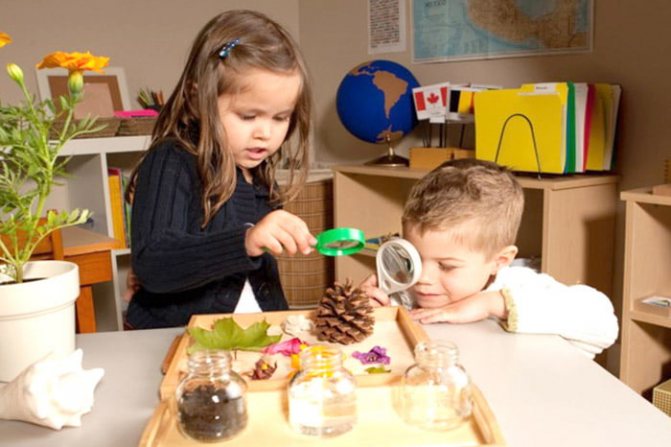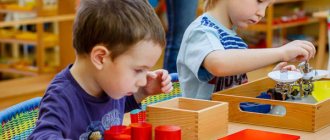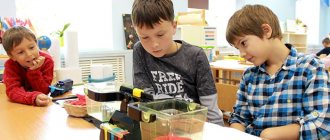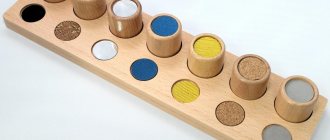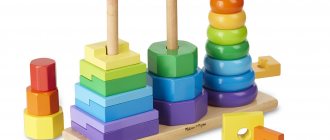For 2.5 years now, my daughter and I have been adherents of the Montessori method - a wonderful early development system that has conquered the whole world, a system based on the idea of free education and deep respect for the interests of the child. I will not repeat myself and talk about the basic principles of the methodology; they were previously written about here. In this article I would like to dwell on how to implement the Montessori method at home. After all, going to a developing Montessori club is one thing, but maintaining the spirit of free education at home is completely different, perhaps this is an even more important component.
You may have already read my article on the website about implementing the Montessori method at home. Now before you is a revised version of the article, written taking into account our accumulated experience in applying the methodology.
So, if you want your child to develop harmoniously, learn to play independently, and at the same time enjoy playing not only with flying fairies and cars, but also with educational educational toys, so that he learns to clean up after himself, then you simply need, firstly, create a developmental environment , and secondly, give the child complete freedom of action in this environment.
And here's what you need for this:
Age-appropriate educational materials
The experience of Maria Montessori showed that children are most interested in those activities and objects that are connected with the real life of adults. Therefore, the children's environment should replicate the adult one: let the children's room have dishes, all kinds of jars, boxes, provide the child with everything necessary so that he can pour water, string beads, cut paper, wipe off dust, etc. The Montessori system places great importance on the development of fine motor skills, so don’t forget about playing with beads, buttons, tweezers, clothespins, etc.
I write in detail about what games will be interesting to a child at each stage of development in the sections “Development of fine and gross motor skills” and “Ready lesson programs.”
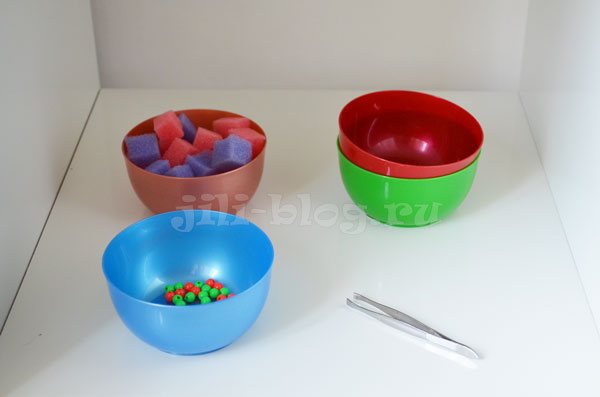
conclusions
Today we introduced you to the Montessori development method for children under one year old. As you can see, the activities do not require much effort, but have a significant impact on the child's development.
First of all, make sure that your baby has a comfortable area to sleep and study, and that mom and dad are nearby and talk to the baby as often as possible. After this, select suitable educational Montessori materials for your baby, but remember, children from 0 to one year develop differently, so activities should be selected based on the child’s interests. Don’t worry if your baby is slightly behind the monthly breakdown we suggested; in just a few weeks he will most likely catch up with his peers.
Proper storage for toys
Very often, in children's rooms, all toys are stored in containers or deep toy baskets. In essence, this is a toy dump where it is almost impossible to find anything specific. Yes, a small child will never do this, he simply forgets about those toys that are lying at the bottom of the basket.
In a properly organized play space, all materials are arranged on racks and shelves. At the same time, all the shelves are located at the child’s level so that he can independently take any benefit that interests him. Each material has its own specific place here, which means the child always knows where to get what he needs and where to put it away later.
In Montessori development centers, the play space usually looks something like this:
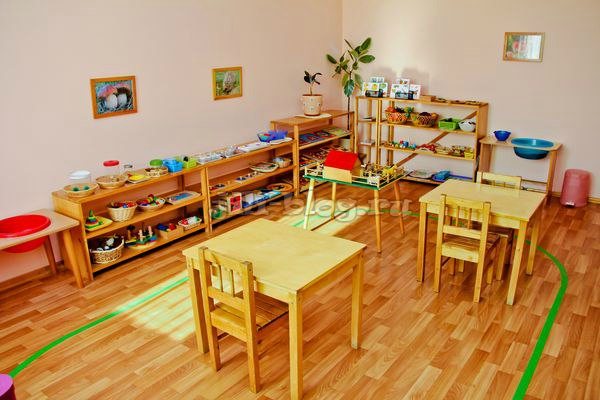
However, it is very difficult to do something similar in an ordinary city apartment, because all these shelves require a lot of space, and you also need to put a closet somewhere and a bed... Therefore, at home you can make a more simplified version with fewer shelves . In addition, you do not need to post all the manuals at once, as in a development center; you can post a limited number of toys and rotate them regularly. This approach will not only save space in the room, but also help maintain the child’s interest in toys; they will not become boring. More on this below.
Thus, to organize a Montessori environment at home, one 2-3-tier rack is quite enough. It can be made to order or use ready-made solutions. We bought our rack at an Ikea store, this is what it looked like at 2 years old:
When such a shelving unit appeared in our nursery, it immediately became clear that this was a huge boon! I’m not talking about my daughter’s delight at all. Previously, frame inserts, knockers and other equipment were lying on the windowsill, where everyone always forgot about them, now everything was in plain sight, both for my daughter and for me. When Taisiya started playing, it was immediately clear what to tackle
There are several important points that you need to know in order to organize a competent Montessori environment in which your child will always be interested.
1. There shouldn’t be a lot of toys on the rack!
Firstly, a limited set of toys makes it easier for the child to choose and helps him concentrate on something specific. Secondly, if the shelves are chock full of developmental materials, then getting to any specific one becomes not so easy. Well, if a child experiences difficulties associated with pulling out and putting away the material, then with a high degree of probability he will prefer not to play with it at all.
2. It is necessary to constantly change the toys displayed on the rack.
When I first organized a shelving unit for my daughter, I was guided by the display of the development club - absolutely all the developmental materials available were laid out there. I wanted Taisiya to have a full selection of materials at home, so I pushed into the rack all the educational toys we had that were currently suitable for my daughter’s age. Some time passed before I realized that my daughter simply stopped noticing the toys that were constantly in the rack! They became so familiar to her that they seemed completely uninteresting.
Then I did what should have been done from the very beginning: I put all the toys in a closed cabinet, and put only a limited set of materials on the shelves so that each one was clearly visible. Every week I began to conduct a small audit: I removed from sight those toys in which there was no interest, and replaced them with others. And here the second life of our Montessori shelving began! Materials that no one had looked at before began to sparkle with new colors.
Regular rotation of toys is really very important, it helps to maintain the child's constant interest in developmental aids. It also allows you to get by with a small set of toys, since, disappearing from the child’s field of vision, they are soon perceived as a new thing.
Naturally, in order to meet the baby’s changing interests and promote his further development, completely new materials need to be displayed from time to time.
3. Toys should be at a height accessible to the child
(no higher than eye level), so that he can take from the shelf and put back any benefit that interests him without the help of an adult.
4. Each item on the rack should have its own place.
If possible, place toys so that they are visually separated from each other (at a short distance from each other).
5. The rack must be open.
Avoid anything that blocks the child’s view of the contents of the shelves: a large number of drawers, doors, etc.
Maria Montessori recommends distributing all materials into zones. In your shelving, you can also group games by meaning. For example, in one compartment you can always lay out insert frames, in another - cubes and construction sets, in the third - lacing, fasteners,
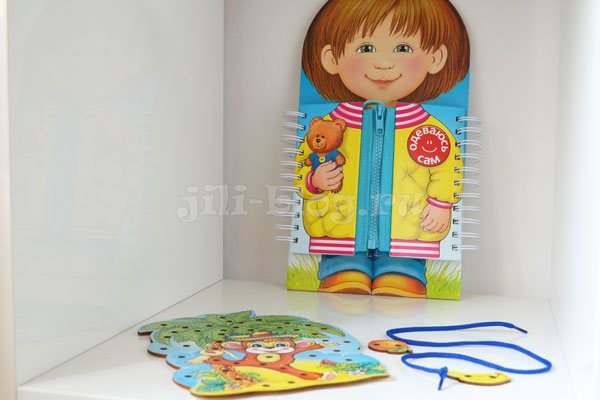
in the fourth - puzzles,
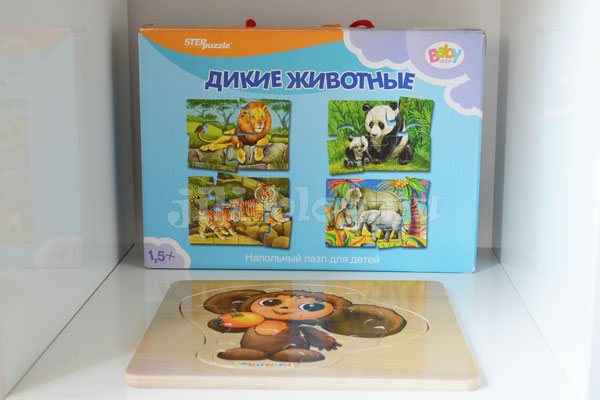
in the fifth - musical instruments, etc.
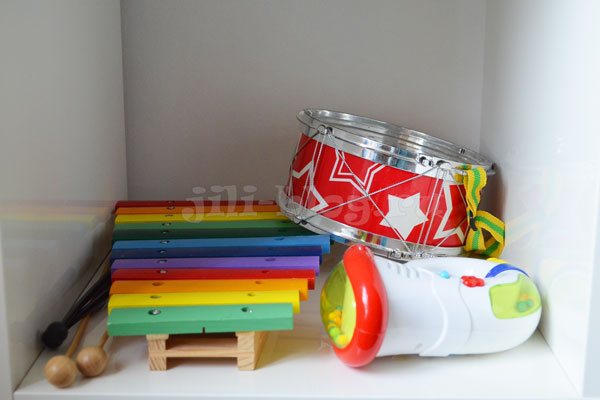
Despite the fact that Maria Montessori paid little attention to role-playing play, I am convinced that role-playing toys are also necessary on the shelf. For us, these sections have always been one of the most used.
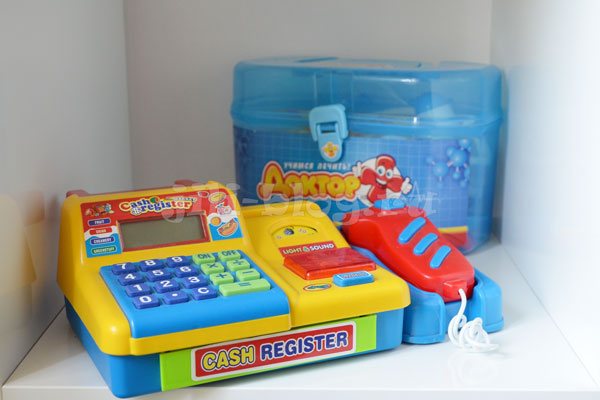
Montessori at home: 48 activity ideas
On our website you can purchase the product you are interested in using one of the payment methods:
Payment security and confidentiality
When you select this form of payment for your order on the ViLine.tv website, you will be automatically redirected to the payment form of the PayU processing center to enter your bank card details. All data entered by you on the payment form of the PayU processing center is fully protected in accordance with the requirements of the PCI DSS security standard. We receive information only about the payment you made. A payment authorization message will be sent to the email address you specified when making the payment. Immediately after making the payment, you will be redirected back to our website. Information about your payment can reach us from 5 seconds to several minutes. If in your opinion there has been a delay in order processing, you need to contact the company office by phone
Buyer's personal information.
When submitting an Application on the Website, the Client provides the following information: Last name, First name, email address, phone number, delivery address. The Seller uses the information to fulfill its obligations to the Client. The Seller undertakes not to disclose information received from the Client. It is not considered a violation for the Seller to provide information to agents and third parties acting on the basis of an agreement with the Seller to fulfill obligations to the Client.
There is no breach of obligation to disclose information in accordance with reasonable and applicable legal requirements. The Seller is not responsible for the information provided by the Client on the Site in a publicly accessible form.
After payment, log into your “Personal Account” and select “My Courses” There you will find all the products that you purchased on our website ViLine.tv If you have not received your product within an hour after payment, you must write to support
Refund Policy
The Customer has the right to refuse to provide paid Services and demand a refund in the following cases:
1. For a paid electronic product (recording of a webinar, seminar, training, training course, templates and supporting materials available for download). A request for a refund must be sent from the email address from which the order was made to the Contractor's support service within 7 (seven) days from the date of payment. After the specified time, claims will not be accepted and funds will not be returned. When submitting an application for a refund, it is necessary to provide a copy of an identification document (passport).
2. For a seminar or consultation paid for and attended by him. A request for a refund must be sent from the email address from which the Customer registered for the seminar to the Contractor’s support service before 14:00 Moscow time on the day following the day the Service was provided. After the specified time, claims will not be accepted and funds will not be returned. When submitting an application for a refund, it is necessary to provide a copy of an identification document (passport).
Furniture and play equipment according to the child’s height
To prevent your baby from feeling like a midget in the land of giants, it is advisable to purchase furniture for him according to his height. A children's table and chair are primarily needed to ensure that the baby sits in the correct position during creative activities, and also to ensure that the child has the opportunity to independently prepare his/her own work space (bring paints, brushes). A children's easel and magnetic board will also be very useful.
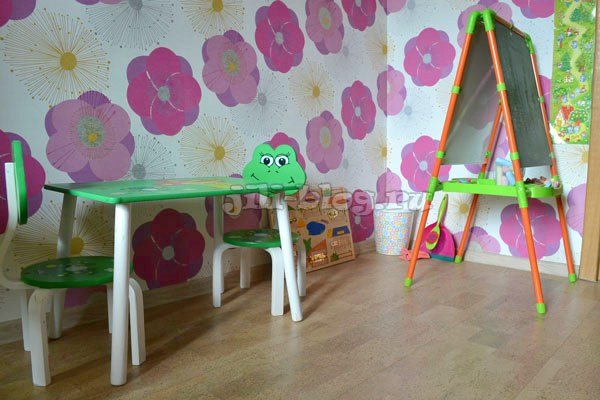
Pouring water
Material: tray, watering can made of transparent material with a water level mark, vessel with a large hole, rag.
Goal: development of coordination of movements. Help you navigate the world around you.
Age: about three years.
How to work with the material. The watering can is filled to the mark with colored water. (If the watering can is overfilled, then pouring water becomes difficult). The watering can and the vessel stand next to each other. Order in the workplace is important. The teacher takes the watering can by the handle, lifts it high, tilts it over the vessel and slowly pours water until the vessel is full. With a weak tug, he returns the watering can to its previous position, takes a rag with his other hand, wipes away the remaining drops and places the watering can on the table again. He takes the filled vessel, lifts it to the height of the watering can and pours the water back into the watering can. Then he wipes the remaining drops with a rag and puts the vessel back on the table. A particularly interesting point! The teacher demonstrates the exercise, slowly and clearly performing the movements, and always with obvious interest in his lesson. The introduction should not be interrupted until the child understands the entire course of action. He invites the child to repeat the exercise and watches him as he does so. Finally, the exercise can be varied by taking a larger number of vessels or a vessel with different properties, for example, with a small hole.
Personalized cleaning products for your baby
An integral part of the Montessori system is providing the child with the opportunity to clean up after himself. Give your child a cloth, a sponge, a small mop, a brush and a dustpan for his own use so that he can clean up spilled grain or spilled water during play. Let cleaning products always be in a place specially designated for them. There must be a trash basket in the baby's room.

Frames with clasps
Wooden frames with various fasteners: large buttons, small buttons, snaps, bows, string that goes through a hole, string that wraps around hooks and eyes, strap fasteners, Velcro fasteners.
Material. As an example, we give the work with a bow clasp. A square wooden frame covered with fabric consisting of two halves, with 5 ribbons sewn on the inside of them. The ribbons of one half differ in color from the ribbons of the other.
Goal: untying and tying bows, development of motor skills, coordination of movements.
Age: about three years.
How to work with the material. The teacher begins to untie one bow after another from bottom to top. He grabs the ends of the ties and pulls them in different directions. Tying a bow is a very difficult task. Through analysis of the course of events and repetition, the child understands the course of action more clearly. He unties all the knots from bottom to top, folds the halves of the fabric in different directions and straightens the ties from different sides. With both hands, he grabs the halves of the fabric in the corners and brings them together in the middle. He takes the two bottom ties and places them on top of each other in a cross pattern. Actions with ties are not performed with the whole hand, but only with the hand. The same thing happens with all other ties. Then the teacher inserts the end of the top tie under the bottom one and pulls it. This is how a knot is formed. He forms a loop from one string and holds it close to the knot with his thumb and forefinger. Using the thumb and forefinger of his other hand, he guides the loose tie from front to back around the loop and pushes it through the hole above the knot. Then the teacher performs the action with two loops at the same time, so that they form a bow with equal ends. The child can repeat the exercise in full or only part. Error control: Fabric halves do not fit together. The bow unties itself.
Application: tie a bow on your own clothes or on another child’s clothes. Help in gaining independence.

Montessori games. Pouring water. Photo by KOBU Agency on Unsplash
Creative corner
Very often, paints, plasticine, and glue are stored in drawers and other places inaccessible to children. A child draws only when his mother suggests, and not when he wants it. However, it is very important to provide the child with the opportunity for spontaneous creativity.
Try to organize a creative corner for your child so that the same rules about accessibility, limited availability and regular updating of materials are observed.
This could be a creative table in a place convenient for the child or a shelf on your shelf reserved for creative materials. Do not post a lot of different materials there at once; it would be better if they are updated regularly.
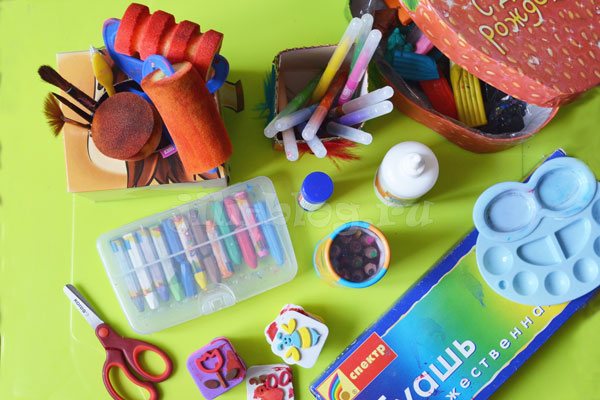
Naturally, if the child is still too young, tastes almost everything and does not yet know the rules for working with certain materials, you should not put glue, sharp scissors or liquid paints in the public domain. But you can already put a stack of paper and a few wax crayons.
Find a cap by size (from 2 to 4 years)
Objectives of the exercise : development of visual and motor coordination.
You will need: 4-6 bottles or jars of different sizes with lids (the lids can be stored in a small container).
Presentation : place bottles on the table in front of the child; slowly remove the caps and screw them back on; First, put on the caps that match the size of the bottles, then mix the caps and let the child choose the right caps for the bottles.
Advantages and disadvantages of the system
Any system has supporters and opponents. The first see the advantages in it, the second - the disadvantages. What are the pros and cons of the Montessori system?
Flaws:
- the lack of a traditional lesson system makes it difficult to adapt to a regular school;
- teachers need to be trained for a very long time;
- a large number of special educational materials are expected, mostly natural, produced using complex technologies, and therefore expensive, not accessible to everyone. Hence the high cost of classes in such centers;
- Intellectual abilities during such training prevail over creative ones, which are regarded as a departure from reality;
- Reading for a child is just a process of obtaining information;
- the emphasis on independence limits communication with other children;
- Ordinary toys are practically not used.
Advantages:
- the system motivates children to study;
- teaches you to independently plan your work and organize it;
- helps you independently find answers to questions that arise, find errors, and correct them;
- teaches responsibility and mutual assistance;
- provides the basics of knowledge about the world around us;
- helps develop logical and analytical capabilities;
- develops speech and intelligence.
Such children are able to adapt well to society and grow up to be very successful. And children with special needs have the opportunity to catch up with their peers in development.
